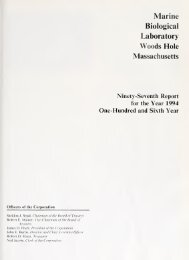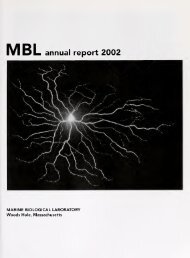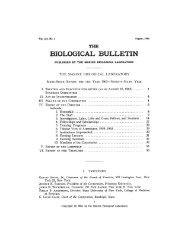44 researchprogram in molecular physiologyDIRECTORPeter J.S. SmithPROGRAMADMINISTRATORTiffany Van MooyADJUNCT SCIENTISTSAyse Dosemici, NNDS,NIH, BethesdaMiguel Holmgren, NNDS,NIH, BethesdaGeorge Holz, New York<strong>University</strong>Ron Pethig, <strong>University</strong>of Northern WalesBIOCURRENTSRESEARCH CENTERDIRECTORPeter J.S. SmithPROGRAMADMINISTRATORTiffany Van MooyRESEARCH ASSISTANTSCIENTISTSMark MesserliEmma HeartPOSTDOCTORALSCIENTISTSLeon CollisDamon OsbournAnthony MolinaRESEARCH ASSOCIATERichard SangerBROWN UNIVERSITYROTATIONLorin JakubekRESEARCH ASSISTANTSDaniel BogorffErica CorsonCraig HamiltonRobert LewisGRAPHICS ANDDATABASE DEVELOPERTamara ClarkINFORMATICSDave RemsenSUMMER INTERNJames PringleLABORATORY OFROBERT GREENBERGASSOCIATE SCIENTISTRobert GreenbergPOSTDOCTORALSCIENTISTShanta MesserliJoseph ConsiglioRESEARCH ASSISTANTChristine EvolaWill MorganThe goal of the Program in Molecular Physiology (PMP) is to advance our knowledgeof basic and biomedical problems through the study of cellular dynamics in the livingcell. Most of the work being done focuses on physiological and transport dynamics atthe molecular, cellular, and systemic level. An important component of these studies isthe development and application of advanced techniques for the detection of specificmolecules and structures. This is largely the activity taking place in the BioCurrentsResearch Center (BRC), a significant part of the Program funded by the National Centerfor Research Resources (NCCR:NIH). This work follows a long and successful traditionwithin the MBL community for the non-invasive study of living cells, notably pursuedby Shinya Inoué and Rudolf Oldenbourg of the Architectural Dynamics Program, aleading component of cell sciences at the MBL. The focus of the research within theBRC group and our collaborators is the use of boundary layer electrochemistry to detectthe transport of selected solutes across the plasma membrane. This research programcontinues to offer access to advanced electrochemistry, electrophysiology, and imagingtechniques—the latter includes low light and luminescent, as well as spinning discconfocal. The laboratory of Robert Greenberg, the second major component of thePMP, is working to better understand the neuromuscular system of schistosomes atthe molecular level, with an eventual goal being to provide possible molecular targetsfor new, potent and specific antiparasitic agents. Schistosomes, or blood flukes, areflatworms that parasitize humans and cause schistosomiasis, a widespread tropicaldisease that affects approximately 200 million people, killing as many as 280,000 peopleper year. Greenberg’s lab brings a strong molecular perspective to the program, as wellas a very interesting biological challenge.Over the past year Greenberg’s group has continued to study voltage-gated calciumchannels (VGCCs) from schistosomes, which express a VGCC β subunit subtypewith unique structural and functional characteristics, including the ability to conferpraziquantel sensitivity to VGCCs that normally do not respond to the drug. This βsubunit is also unique because it lacks two highly conserved consensus protein kinase Cphosphorylation sites in a critical region of the protein. They have proposed that thosemissing sites are determinants of the unusual functional properties and pharmacologicalsensitivities of this β subunit, and are using site-directed mutagenesis to test thathypothesis. Several other biophysical and molecular aspects of this channel are alsobeing studied. In addition to this work, Greenberg and colleagues are examining nitricoxide (NO) regulatory pathways in schistosomes. To date, they have demonstrated thepresence and distribution of nitric oxide synthase immunoreactivity and enzymaticactivity in adult schistosomes. Using fluorescent probes, they have demonstrated theproduction and distribution of authentic NO in living worms. Currently, this aspectof Greenberg’s work is developing the use of high-throughput methods to defineNO-responsive genes in schistosomes. This part of the study is being pursued incollaboration with Andrew McArthur of the Bay Paul Center.
esearch 45The BRC has hit the ground running in this first year of the new funding cycle, alreadyachieving certain key goals, as well as developing several new ones. A long-term challengeof remote positional control of electrochemical sensors was published this year by usingimpedance feedback to regulate sample-probe separation. New electrochemical methodsare being explored for the detection of glycerol, phosphate, amines, and lactate all inresponse to our strong collaborative group. Technical advances in mapping channelactivities and drug transporters have also occurred. Two reviews, one in plant sciences andthe other in neurosciences, are in press, covering the self-referencing technique developedprimarily by the BRC. Imaging capabilities have expanded, particularly with regard to lowlight luminescent methods targeted for studies on metabolism through luciferin/luciferaseATP dependent interaction. For these experiments, developed and now available, are viralluciferase constructs for transfection. A long-term endeavor of the group is the modeling ofion distribution and diffusion behavior with the boundary layer of isolated cells and withinthe tortuous intercellular space of tissue. This work has moved forward in collaborationwith the Pittsburgh Supercomputing Facility, Carnegie Mellon (www.mcell.psc.edu/apps4.html). This year also saw the first use of dielectrophoresis and electrorotation formeasurement of membrane characteristics and cell manipulation. To define the transportmechanisms behind solute movements, pharmacology is a critical tool. To ease the useof these compounds and to more accurately establish experimental protocols, the BRCPharmabase (Pbase) project has continued to expand and has added a graphics search toolto this open access database (www.Pharmabase.org). Pbase will also feature as a chapter inCurrent Protocols in Bioinformatics (Wiley and Sons, in press).The program continues its tradition of extensive outreach through collaborative science.This reporting year saw over 40 visiting investigators/collaborators working with membersof the program on both applications and instrument development. Members of theprogram continue to contribute and support off-campus grant applications. This year thebiological and biomedical studies have shown a growing emphasis on cellular metabolism,with a notable concentration of effort in diabetes-related research but also on single neuronmetabolism and manipulation. These disciplines take advantage of many unique toolsand talents here at the MBL and have led to several high-profile publications and verypromising avenues of enquiry. Two collaborative modules were also launched this year—Toxicology and Physiology of Development, and Polarity. The BRC, in conjunction withSociety for Developmental Biology (SDB), is sponsoring their first focused workshop on thephysiology of polarity and development (www.BioCurrents.org/polaritysession.html). Thisnew venture is being organized by Mike Levin of the Forsyth Institute (Harvard) and willtake place before the main SDB meeting in June 2006 in Ann Arbor.PublicationsBeaulieu, V; Da Silva, N;Pastor-Soler, N; Brown,CR; Smith, PJS; Brown,D; Breton, S. 2005.Modulation of the actincytoskeleton via gelsolinregulates vacuolar. J.Biol. Chem. 280(9): 8452-8463.Brown, MA; Begley, GS;Czerwiec, E; Stenberg,LM; Jacobs, M; Kalume,DE; Roepstorff, P;Stenflo, J; Furie, BC;Furie, B. 2005. Precursorsof novel Gla-containingconotoxins containa carboxy-terminalrecognition site thatdirects β-Carboxylation.Biochemistry 44(25):9150-9159.Garber, SS; Messerli,MA; Hubert, M;Lewis, R; Hammar, K;Indyk, E; Smith, PJS.2005. Monitoring Clmovementin single cellsexposed to hypotonicsolution. J. MembraneBiol. 203(2): 101-110.Greenberg, RM. 2005.Are Ca (2+) channelstargets of praziquantelaction? Int. J. Parasitol.35(1): 1-9.Li, RL; Chase, M; Jung,SK; Smith, PJS; Loeken,MR. 2005. Hypoxicstress in diabeticpregnancy contributesto impaired embryogene expression anddefective developmentby inducing oxidativestress. Am. J. Physiol.Endocrinol. Metabolism289(4): E591-E599.MacLellan, JD; Gerrits,MF; Gowing, A; Smith,PJS; Wheeler, MB;Harper, ME. 2005.Physiological increasesin uncoupling protein3 augment fatty acidoxidation and decreasereactive oxygen speciesproduction withoutuncoupling respirationin muscle cells. Diabetes54(8): 2343-2350.Messerli, MA; Amaral-Zettler, LA; Zettler, E;Jung, SK; Smith, PJS;Sogin, ML. 2005. Lifeat acidic pH imposesan increased energeticcost for a eukaryoticacidophile. J. Exp. Biol.208: 2569-2579.Osbourn, DM; Sanger,RH; Smith, PJ. 2005.Determination of singlecelloxygen consumptionwith impedancefeedback for control ofsample-probe separation.Analytical Chem. 77(21):6999-7004.Pethig, R; Jakubek, L;Sanger, RH: Heart, E;Corson, E; Smith, PJS.2005. Electrokineticmeasurements ofmembrane capacitanceand conductance forpancreatic β-cells. IEEProc. Nanobiotechnol.152: 189-193Twig, G; Graf, SA;Messerli, MA; Smith,PJS; Yoo, SH; Shirihai,OS. 2005. Synergisticamplification of betaamyloid-and interferongamma-inducedmicroglial neurotoxicresponse by the senileplaque componentchromogranin A. Am.J. Physiol. Cell Physiol.288(1): C169-C175.
- Page 1 and 2: MBL7 MBL StreetNon-profit Org.U.S.
- Page 5: contents1 report of the director an
- Page 8 and 9: 2 report of the director and ceoTha
- Page 10 and 11: 4 program profiles“Our lives are
- Page 12 and 13: 6 program profilesoffering unmatche
- Page 14 and 15: 8 program profilestraining pre and
- Page 16 and 17: 10 program profilesforging powerful
- Page 18 and 19: 12 program profilesengaging undergr
- Page 20 and 21: 14 program profilesexciting k-12 te
- Page 22 and 23: 16 researchresearchThe MBL is one o
- Page 24 and 25: 18 researchgenomes. The National Ae
- Page 26 and 27: 20 researchPublicationsAmaral Zettl
- Page 28 and 29: 22 researchThe High Cost of Coastal
- Page 30 and 31: 24 researchJohn Hobbie Named MBL Di
- Page 32 and 33: 26 researchwhitman centerThe Whitma
- Page 34 and 35: 28 researchA New Twist on Power Wal
- Page 36 and 37: 30 researchfellowshipsMBL Research
- Page 38 and 39: 32 researchAlbert and Ellen Grass F
- Page 40 and 41: 34 researchFriday Evening Lecture S
- Page 42 and 43: 36 researcharchitectural dynamics i
- Page 44 and 45: 38 researchBUMP staff, cont.PH.D. S
- Page 46 and 47: 40 researchmarine resources program
- Page 48 and 49: 42 researchMarine Resources Program
- Page 52 and 53: 46 researchlaboratory of aquatic bi
- Page 54 and 55: 48 researchlaboratory of norman wai
- Page 56 and 57: 50 educationsummer coursesBiology o
- Page 58 and 59: 52 educationGreenberg, Everett, Uni
- Page 60 and 61: 54 educationMaul, Kristen, City Col
- Page 62 and 63: 56 educationPata, Veena, National I
- Page 64 and 65: 58 educationspecial topics coursesA
- Page 66 and 67: 60 educationMaiato, Helder, Institu
- Page 68 and 69: 62 educationBrower, Stewart, Univer
- Page 70 and 71: 64 educationFACULTYCurran, Sean, Ma
- Page 72 and 73: 66 educationGeunes-Boyer, Scarlett,
- Page 74 and 75: 68 educationSTUDENTSAparicio, Paul,
- Page 76 and 77: 70 educationother educational progr
- Page 78 and 79: 72 educationscholarship awardsIn 20
- Page 80 and 81: 74 educationCaswell Grave Scholarsh
- Page 82 and 83: 76 educationMilton L. Shifman Endow
- Page 84 and 85: 78 mblwhoi librarytrends, and curre
- Page 86 and 87: 80 financialsfinancialsreport of th
- Page 88 and 89: 82 financialsOperating History and
- Page 90 and 91: 84 giftsWe are grateful as well to
- Page 92 and 93: 86 giftsRestricted gifts(up to $9,9
- Page 94 and 95: 88 giftsMEMBER($1,000 - $2,499)Edwa
- Page 96 and 97: 90 giftsJohn E. Hobbie Fund for Sci
- Page 98 and 99: 92 giftsMr. and Mrs. J. Sterling Cr
- Page 100 and 101:
94 giftsLectureshipsJohn J. Cebra L
- Page 102 and 103:
96 gifts10th AnniversaryDr. Eva M.
- Page 104 and 105:
98 giftsMBL AssociatesThe Associate
- Page 106 and 107:
100 giftsMr. James K. TaylorMrs. Al
- Page 108 and 109:
102 giftsMBL Golf OutingIn July, MB
- Page 110 and 111:
104 giftsFellowships Established in
- Page 112 and 113:
106 giftsSemester in Environmental
- Page 114 and 115:
108 governance & administrationgove
- Page 116 and 117:
110 governance & administrationcorp
- Page 118 and 119:
112 governance & administrationDr.
- Page 120 and 121:
114 governance & administrationcoun
- Page 122 and 123:
116 governance & administrationadmi
- Page 124:
118 governance & administrationPhot
















